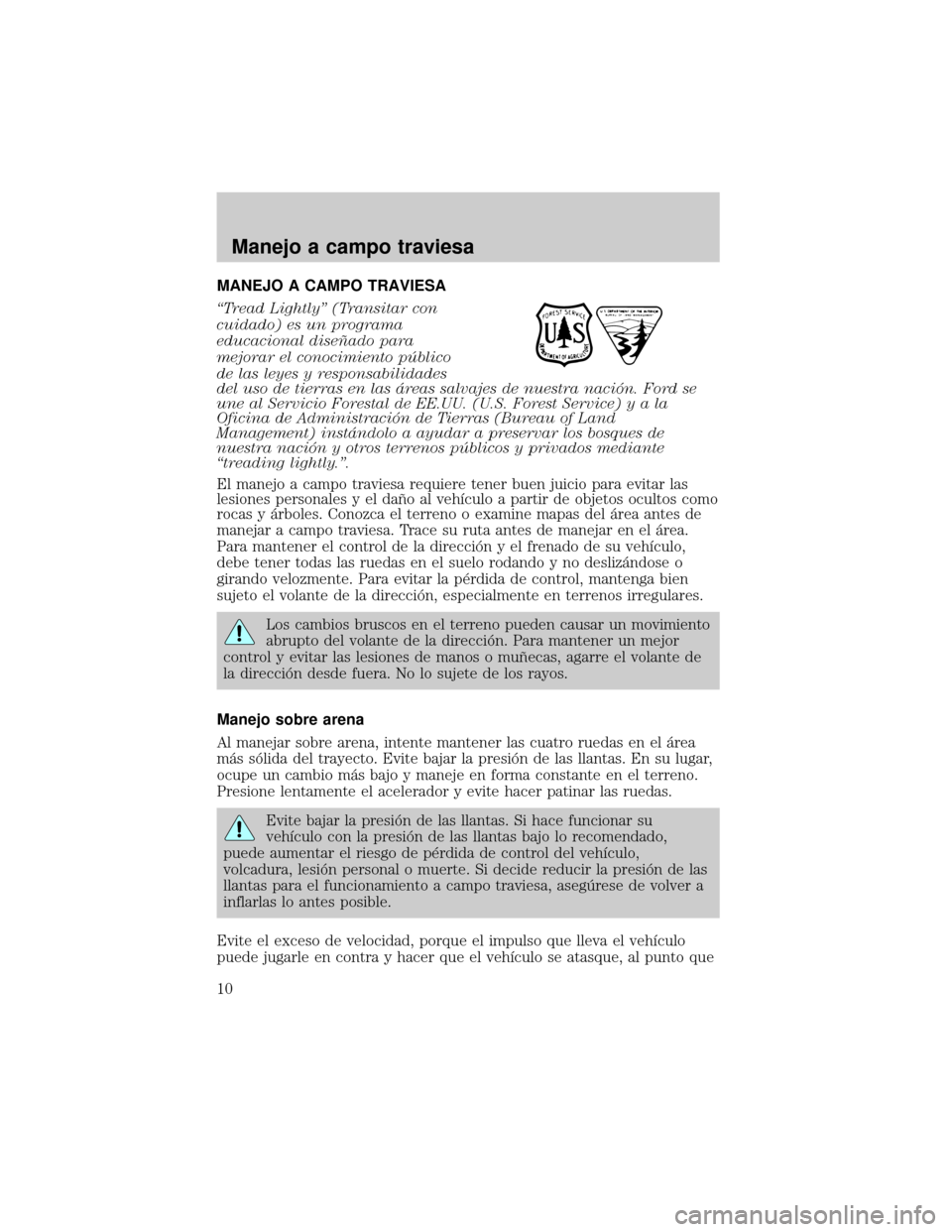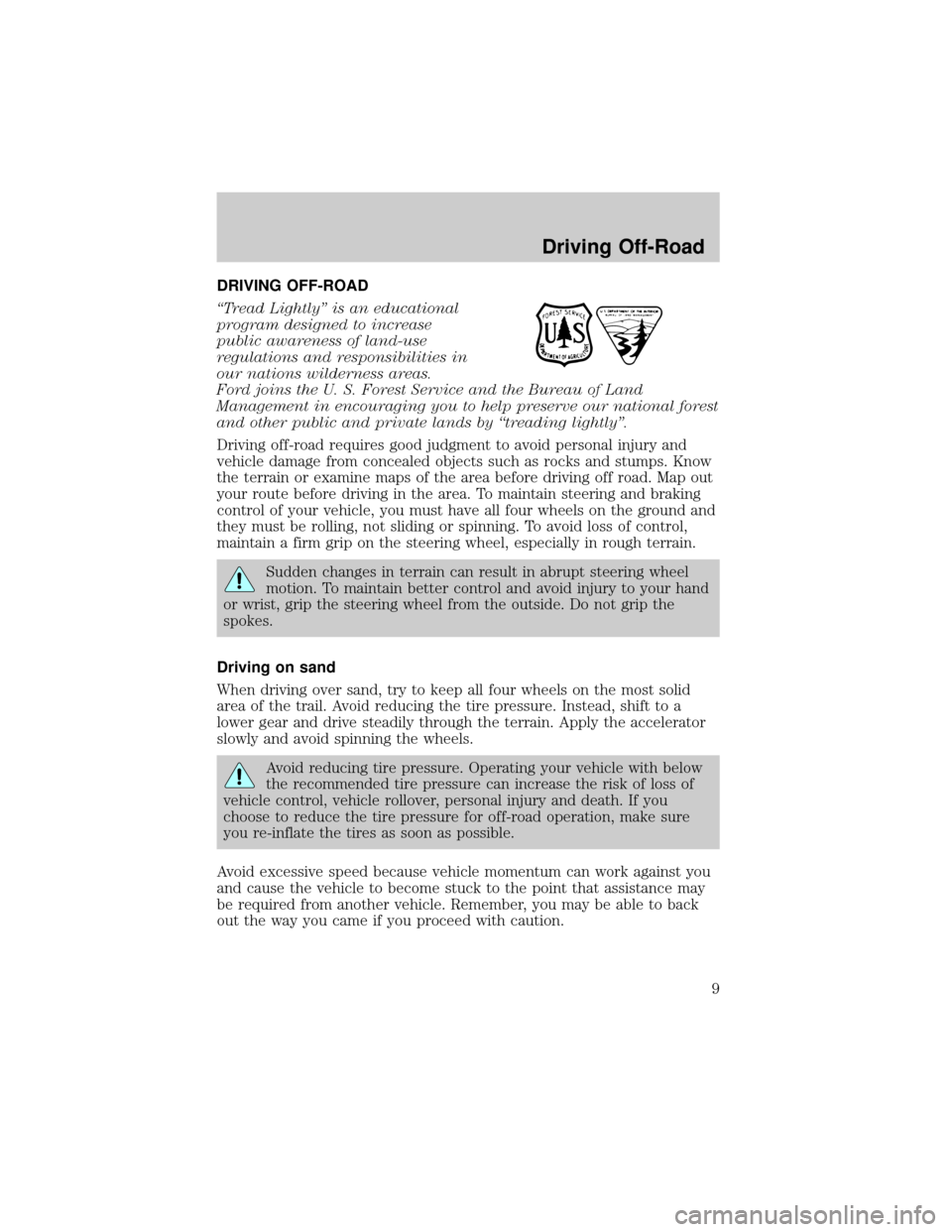light Mercury Mountaineer 2007 Manual de Usuario (in Spanish)
[x] Cancel search | Manufacturer: MERCURY, Model Year: 2007, Model line: Mountaineer, Model: Mercury Mountaineer 2007Pages: 48, tamaño PDF: 0.37 MB
Page 10 of 48

MANEJO A CAMPO TRAVIESA
ªTread Lightlyº (Transitar con
cuidado) es un programa
educacional diseÞado para
mejorar el conocimiento pìblico
de las leyes y responsabilidades
del uso de tierras en las µreas salvajes de nuestra naciân. Ford se
une al Servicio Forestal de EE.UU. (U.S. Forest Service)yala
Oficina de Administraciân de Tierras (Bureau of Land
Management) instµndolo a ayudar a preservar los bosques de
nuestra naciân y otros terrenos pìblicos y privados mediante
ªtreading lightly.º.
El manejo a campo traviesa requiere tener buen juicio para evitar las
lesiones personales y el daÞo al vehÛculo a partir de objetos ocultos como
rocas y µrboles. Conozca el terreno o examine mapas del µrea antes de
manejar a campo traviesa. Trace su ruta antes de manejar en el µrea.
Para mantener el control de la direcciân y el frenado de su vehÛculo,
debe tener todas las ruedas en el suelo rodando y no deslizµndose o
girando velozmente. Para evitar la p×rdida de control, mantenga bien
sujeto el volante de la direcciân, especialmente en terrenos irregulares.
Los cambios bruscos en el terreno pueden causar un movimiento
abrupto del volante de la direcciân. Para mantener un mejor
control y evitar las lesiones de manos o muÞecas, agarre el volante de
la direcciân desde fuera. No lo sujete de los rayos.
Manejo sobre arena
Al manejar sobre arena, intente mantener las cuatro ruedas en el µrea
mµs sâlida del trayecto. Evite bajar la presiân de las llantas. En su lugar,
ocupe un cambio mµs bajo y maneje en forma constante en el terreno.
Presione lentamente el acelerador y evite hacer patinar las ruedas.
Evite bajar la presiân de las llantas. Si hace funcionar su
vehÛculo con la presiân de las llantas bajo lo recomendado,
puede aumentar el riesgo de p×rdida de control del vehÛculo,
volcadura, lesiân personal o muerte. Si decide reducir la presiân de las
llantas para el funcionamiento a campo traviesa, asegìrese de volver a
inflarlas lo antes posible.
Evite el exceso de velocidad, porque el impulso que lleva el vehÛculo
puede jugarle en contra y hacer que el vehÛculo se atasque, al punto que
Manejo a campo traviesa
10
Page 33 of 48

DRIVING OFF-ROAD
ªTread Lightlyº is an educational
program designed to increase
public awareness of land-use
regulations and responsibilities in
our nations wilderness areas.
Ford joins the U. S. Forest Service and the Bureau of Land
Management in encouraging you to help preserve our national forest
and other public and private lands by ªtreading lightlyº.
Driving off-road requires good judgment to avoid personal injury and
vehicle damage from concealed objects such as rocks and stumps. Know
the terrain or examine maps of the area before driving off road. Map out
your route before driving in the area. To maintain steering and braking
control of your vehicle, you must have all four wheels on the ground and
they must be rolling, not sliding or spinning. To avoid loss of control,
maintain a firm grip on the steering wheel, especially in rough terrain.
Sudden changes in terrain can result in abrupt steering wheel
motion. To maintain better control and avoid injury to your hand
or wrist, grip the steering wheel from the outside. Do not grip the
spokes.
Driving on sand
When driving over sand, try to keep all four wheels on the most solid
area of the trail. Avoid reducing the tire pressure. Instead, shift to a
lower gear and drive steadily through the terrain. Apply the accelerator
slowly and avoid spinning the wheels.
Avoid reducing tire pressure. Operating your vehicle with below
the recommended tire pressure can increase the risk of loss of
vehicle control, vehicle rollover, personal injury and death. If you
choose to reduce the tire pressure for off-road operation, make sure
you re-inflate the tires as soon as possible.
Avoid excessive speed because vehicle momentum can work against you
and cause the vehicle to become stuck to the point that assistance may
be required from another vehicle. Remember, you may be able to back
out the way you came if you proceed with caution.
Driving Off-Road
Driving Off-Road
9
Page 34 of 48

Driving in mud
Be cautious of sudden changes in vehicle speed or direction when you
are driving in mud. Even 4WD and AWD vehicles can lose traction in
slick mud. As when you are driving over sand, apply the accelerator
slowly and avoid spinning your wheels. If the rear end of the vehicle
does slide while cornering, steer in the direction of the slide until you
regain control of the vehicle.
After driving through mud, clean off residue stuck to rotating tires,
wheels and driveshafts. Excess mud stuck on tires, wheels and rotating
driveshafts causes an imbalance that could damage vehicle components.
Driving through water
Before driving through water,
determine the depth. Avoid water
higher than the center of the wheel
or hubcap. Proceed slowly to avoid
splashing; if the ignition system gets
wet, the vehicle may stall.
Once through water, always try the
brakes. Wet brakes do not stop the
vehicle as effectively as dry brakes. You can dry the brakes faster by
driving the vehicle slowly while applying light pressure on the brake
pedal.
Driving in deep snow
4WD and AWD vehicles are unique in that they can be driven in deep
snow that would stop a conventional two-wheel drive vehicle. Shift to a
low gear and maintain steady pressure on the accelerator. This will help
prevent spinning the wheels while maintaining sufficient momentum to
keep from bogging down. Using tire chains will also help.
Never drive with chains on the front tires of 4WD or AWD vehicles
without also putting them on the rear tires. This could cause the rear of
the vehicle to slide and swing around.
Driving on hills
Operating your vehicle off-road on slopes or hills requires safe
off-road driving practices. Read and follow these safe off-road
driving practices to reduce the risk of loss of vehicle control, vehicle
rollover, serious injury or death.
Driving Off-Road
10